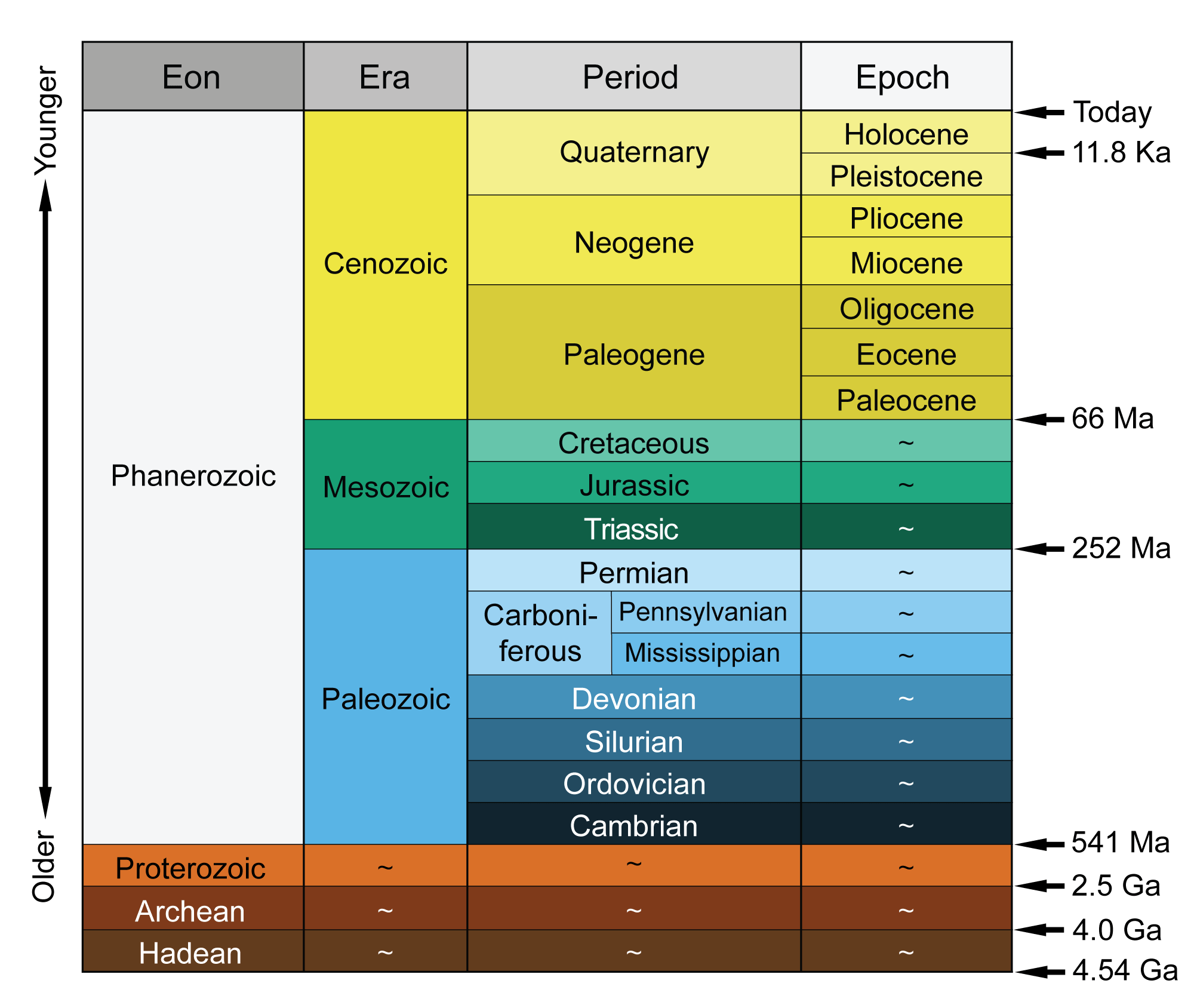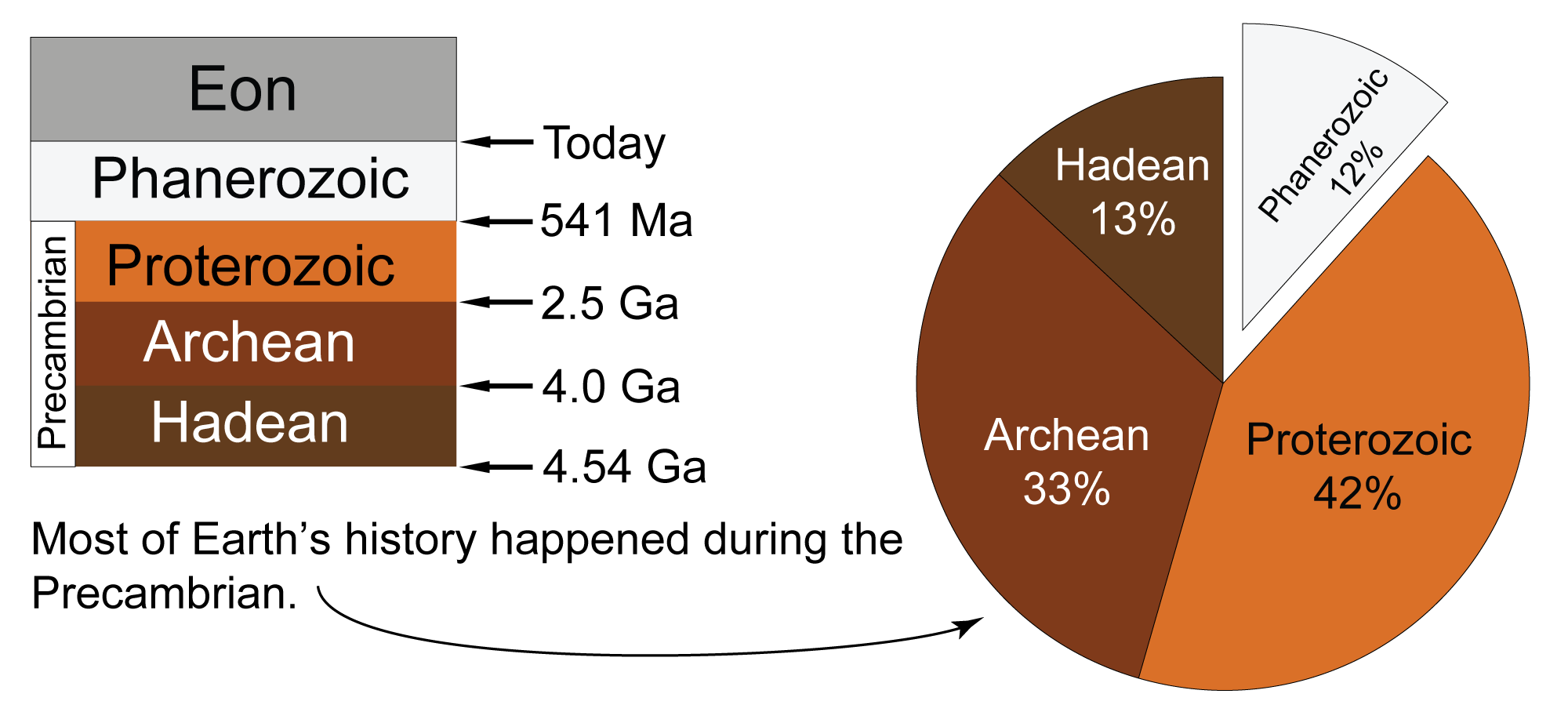You are viewing the article Geologic Time Scale at Lassho.edu.vn you can quickly access the necessary information in the table of contents of the article below.
Overview
Learn below about the ages of important events in the fossil record and Earth’s history during different geologic time intervals. Associated maps show the distributions of rocks from each time interval at or just below Earth’s surface. Note that ages are maximum values and that some exposures end at state lines, indicative of differing age assignments by different institutions (e.g., state geological surveys).
Abbreviations:
- Ka: “kilo anum,” one-thousand years. Kya = thousand years ago.
- Ma: “mega anum,” one-million years. Mya = million years ago.
- Ga: “giga anum,” one-billion years. Bya = billion years ago.
Additional resources:
- High-resolution versions of all of the maps below are available here as a .zip file.
- Geologic maps of individual U.S. states may be viewed here.
- Information about geologic time is available on the Digital Encyclopedia of Ancient Life.
Credits: This page by Jonathan R. Hendricks for the [email protected] project. The maps were created using QGIS and USGS data from Horton et al. (2017) using the maximum age values for each mapped unit. All images have a Creative Commons Attribution-NonCommercial-ShareAlike 4.0 International license. You are welcome to use them for any non-commercial educational purpose.
Updates: Page last updated March 21, 2022.
The Geologic Time Scale

The geologic time scale. Image by Jonathan R. Hendricks for the [email protected] project.
Note that the geologic time scale above is not scaled to time and mostly represents the Phanerozoic Eon. Mosts of geologic history (88%) happened during the Precambrian, which is represented by Hadean, Archean, and Proterozoic eons.

The eons of geologic time and their relative proportions of total geologic time. Image by Jonathan R. Hendricks for the [email protected] project.
Phanerozoic Eon: 541 to 0 mya
Name means “visible life.” Most fossils are known from this time interval. All time before the Phanerozoic is assigned to the Precambrian, which is comprised of the Hadean, Archean, and Proterozoic eons.
Cenozoic Era: 66 to 0 mya
Name means “new life.”
Fossil Record:
- Southeastern U.S.: Coastal Plain and Inland Basin.
- South-Central U.S.: Coastal Plain, Central Lowland and Interior Highlands, Great Plains, and Basin and Range.
Earth History:
Quaternary Period: 2.6 to 0 Ma
The earliest geologic time scale had four intervals: Primary (first), Secondary (second), Tertiary (third), and Quaternary (fourth). Only the Quaternary remains a valid period. Epochs include the Pleistocene and the Holocene.
Fossil Record:
- Extinction of numerous megafauna.
- Origin of Homo.
Earth History:
- Northern hemisphere glaciation and ice age.
Neogene Period: 23 to 2.6 Ma
Formerly part of the Tertiary Period. Epochs include the Miocene and Pliocene.
Fossil Record:
- Famous fossil Lagerstätte: Clarkia fossil beds (Idaho).
- Evolution of hominids.
- Extinction of Megalodon (Otodus megalodon).
- Great American Biotic Interchange.
Earth History:
- Beginning of formation of the Hawaiian Islands.
- Closure of the Central American Seaway due to the rise of the Isthmus of Panama.
- Cooling and drying in North America.
Paleogene Period: 66 to 23 Ma
Formerly part of the Tertiary Period. Epochs include the Paleocene, Eocene, and Oligocene.
Fossil Record:
- Famous fossil Lagerstätten: Eocene Green River Formation (CO, WY, UT; Eocene) and Messel Oil Shale (Eocene, Germany).
- Origin of whales.
- Evolutionary radiation of placental mammals.
Earth History:
- Beginning of formation of the Basin and Range region of the western U.S.
- Beginning of collision of India with Asia, which formed the Himalayan Plateau and affected global climate.
- Paleocene-Eocene Thermal Maximum (PETM; 55 Ma): a geologically short interval of usually warm climate.
Mesozoic Era: 252 to 66 Ma
Name means “middle life.”
Fossil Record:
- Southeastern U.S.: Coastal Plain and Blue Ridge and Piedmont.
- South-Central U.S.: Coastal Plain, Central Lowland and Interior Highlands, Great Plains, and Basin and Range.
Earth History:
Cretaceous Period: 145 to 66 Ma
Named for extensive accumulations of chalk that formed during this time.
Fossil Record:
- Extinction of non-avian dinosaurs at end of period, along with ammonites, mosasaurs, plesiosaurs, pterosaurs, and numerous other groups of marine and terrestrial organisms.
- Famous fossil Lagerstätten: Santana Formation (Brazil).
- Famous dinosaurs: Tyrannosaurus, Triceratops, Velociraptor.
- Origin of angiosperms (flowering plants).
- Origin of placental mammals.
Earth History:
- Bolide impact and volcanism at end of period caused major mass extinction.
- Initial formation of the U.S. Coastal Plain.
- Beginning of the Laramide Orogeny.
- The Western Interior Seaway flooded the mid-continent of North America.
- Earth was warm with high sea level.
- Beginning of the formation of the Rocky Mountains due to shallow subduction in the west.
Jurassic Period: 201 to 145 Ma
Named for the Jura Mountains (Alps).
Fossil Record:
- Famous fossil Lagerstätte: Solnhofen Limestone.
- First birds: Archaeopteryx.
- Famous dinosaurs: Brontosaurus, Apatosaurus, Allosaurus, Archaeopteryx, Stegosaurus.
- Conifers were dominant plant life; cycads also important.
- Ichthyosaurs and plesiosaurs ruled the seas.
Earth History:
- Rift valleys in eastern North America.
- Initial formation of the modern Atlantic Ocean.
- Initial breakup of Pangaea into Laurasia and Gondwana.
- Warm climate.
Triassic Period: 252 to 201 Ma
Named for a three-part series of rocks in Germany.
Fossil Record:
- Origin of mammals.
- Origin of dinosaurs.
- First scleractinian corals.
- Mass extinction at end of period.
Earth History:
- Warm and dry climate.
- Continents united into supercontinent Pangaea.
Paleozoic Era: 541 to 252 Ma
Name means “old life.”
Fossil Record:
- Southeastern U.S.: Coastal Plain, Blue Ridge and Piedmont, and Inland Basin.
- South-Central U.S.: Central Lowland and Interior Highlands, and Basin and Range.
Earth History:
Permian Period: 299 to 252 Ma
Named for the Russian city of Perm.
Fossil Record:
- Period ended with greatest mass extinction in Earth’s history, forever changing life on Earth. Extinction of numerous major groups.
- The age of Dimetrodon.
Earth History:
- Significant volcanism (Siberian traps / flood basalts) and associated rapid warming at end of period caused mass extinction.
- Global sea level falls.
- Continents united into supercontinent Pangaea.
Carboniferous Period: 359 to 299 Ma
Named for the abundant carbon-rich coals that are known from this interval of geologic time. This period is commonly recognized as consisting of two sub-periods: the Mississippian and the Pennsylvanian.
Pennsylvanian Subperiod: 323 to 299 Ma
Named for the state of Pennsylvania.
Fossil Record:
- Famous fossil Lagerstätte: Mason Creek, IL.
- First amniote reptiles (e.g., Hylonomus, Nova Scotia).
- Abundant coal swamps.
Earth History:
- Beginning of the Alleghanian Orogeny.
Mississippian Subperiod: 359 to 323 Ma
Named for the Mississippi River Valley.
Fossil Record:
- Abundant crinoids.
Earth History:
- Shallow sea covered North America; deposition of carbonate rocks such as limestone.
Devonian Period: 419 to 359 Ma
Named for Devon, England. The Devonian is also called the “age of fishes” due to the evolutionary radiation of fish species at this time.
Fossil Record:
- Famous fossil Lagerstätten: Rhine Chert and Hunsrück Slates.
- First forests.
- First seed-bearing plants; plants begin to colonize environments further from water.
- First tetrapods (four-limbed vertebrates).
- Terrestrial arthropods became established; first insects and spiders.
- First ammonites.
- Mass extinctions at the end of the Devonian.
Earth History:
- Acadian Orogeny; collision of eastern Laurentia (proto-North America) with Avalon.
- Antler Orogeny; collision of western Laurentia with a volcanic island arc.
Silurian Period: 444 to 419 Ma
Named for the Silures, an ancient Celtic tribe that lived in what is now Wales, United Kingdom.
Fossil Record:
- Famous fossil Lagerstätte: Waukesha Biota (near Milwaukee, WI).
- First vascular plants on land (e.g., Cooksonia and Baragwanathia).
- First animals on land (arthropods).
- First fish with jaws.
- First bony fish (Osteichthyes)
- Sea scorpions (eurypterids) plentiful.
Earth History:
- Passive margin in eastern Laurentia.
- Warm conditions; evaporation of shallow inland seas formed large deposits of evaporites such as salt.
- Shallow seas covered much of the continents.
Ordovician Period: 485 to 444 Ma
Named for the Ordovices, an ancient Celtic tribe that lived in what is now Wales, United Kingdom.
Fossil Record:
- First land plants (non-vascular plants like moss).
- First fungi.
- First fish (jawless).
- Major radiation of animal life in the oceans, known as the Great Ordovician Biodiversification Event (GOBE).
- Great diversity of trilobite species.
- First tabulate and rugose corals.
Earth History:
- Mass extinction at end of period due to global cooling and formation of glaciers on Gondwanaland. Falling sea levels left shallow water animals without habitat.
- Earth hot at beginning of period, with shallow seas covering much of the continents.
- Taconic Orogeny: Island arcs collided with eastern Laurentia (porto-North America).
Cambrian Period: 541 to 485 Ma
Named for Cambria in Wales, United Kingdom.
Fossil Record:
- Famous fossil Lagerstätten: Burgess Shale (British Columbia), Chengjiang Biota (China).
- All known life lived in the ocean.
- Trilobites abundant, very diverse, and are the most important fossils for dating Cambrian rocks. They are the earliest known animals with eyes.
- Fossils of all major animal groups (phyla) appeared in the Cambrian (Cambrian Explosion/Radiation), but their evolution may go back to the late Proterozoic).
- Oldest known mineralized fossils are the Cambrian “Small Shellies.”
- Beginning defined by the trace fossil Treptichnus.
Earth History:
- Sea-level rise during period.
- Extensive quartz sandstones deposited in shallow seas.
- Continents dispersed.
Precambrian: 4.54 Ga to 541 Ma
The Precambrian is not a formal interval of geologic time. It represents all of Earth history prior to beginning of the Phanerozoic Eon. It was once thought that Precambrian rocks were devoid of fossils, but we now know that is incorrect.
Fossil Record:
- Southeastern U.S.: Blue Ridge and Piedmont.
- South-Central U.S.: None.
Earth History:
Proterozoic Eon: 2.5 Ga to 541 Ma
Name means earlier (“protero-“) life (“-zoic”).
Fossil Record:
- First trace fossils (Russian; 550 Ma).
- First macroscopic multicellular life (Ediacarans, some of which may have been animals; ~575-541 Ma).
- First micoscopic multicellular life (Doushantuo embryos, 635 Ma).
- First eukaryotes (algae called acritarchs; 2.0 Ga).
Earth History:
- Supercontinent of Pannotia (formed ~650 Ma; broke apart ~550 Ma).
- Major ice age at end of eon (“Snowball Earth”); much of Earth may have frozen over (~700 Ma).
- Formation of Laurentia (proto-North America) by suturing of protocontients (1.3 to 1.0 Ga)
- Grenville Orogeny results in formation of supercontinent Rodinia (formed ~1.3 to 1.0 Ga; broke apart ~750 Ma).
- Increasing levels of atmospheric oxygen due to photosynthetic life.
- Development of banded iron formations (BIFs), which are important for steel industry.
- Accretion of protocontinents into larger continents (30-40% modern amount of continental crust by 2.5 Ga).
Archean Eon: 4.0 to 2.5 Ga
Name from the Greek word arkhē, which means the beginning or origin.
Fossil Record:
- Oldest known fossils (stromatolites formed by prokaryotic cyanobacteria; 3.5 Ga).
- Oldest chemical evidence of life (3.8 Ga).
Earth History:
- Rocks of this age are rare.
- Cooling of Earth’s interior.
- Numerous small “protocontinents” covered the Earth.
- Little to no free oxygen.
Hadeon Eon: 4.54 to 4.0 Ga
Named for Hades, the mythological Greek underworld. There are no Hadean-aged rocks.
Fossil Record:
- No evidence of life.
Earth History:
- Oldest known rock (Acosta Gneiss, Northwest Territories, Canada; 4.0 Ga)
- Development of atmosphere and oceans.
- Oldest known mineral grain (zircon; 4.4 Ga)
- Formation of Earth’s crust and differentiation of interior.
- Formation of the Earth (accretionary phase; 4.54 Ga).
Thank you for reading this post Geologic Time Scale at Lassho.edu.vn You can comment, see more related articles below and hope to help you with interesting information.
Related Search:

